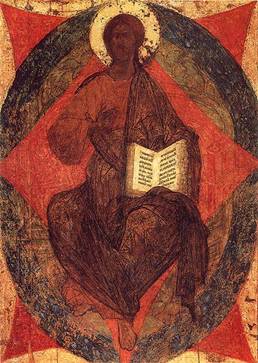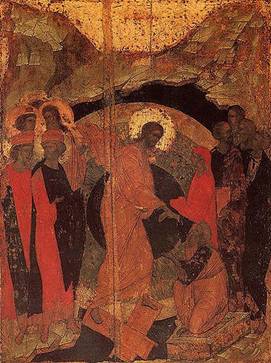Verdad Magazine Volume 12
Spring 2012, Volume 12
Essay by Peter Bonner
Strange Shapes
Some years ago I was on a train traveling out of Moscow to visit a Monastery called The Trinity Lavra of St. Sergius in the town Sergiyev Posad. This monastery is the home of many icons painted by Andre Rublyov and the main destination of Russian Orthodox Christians who make pilgrimages from all over Russia. My reasons for visiting were less religious, although I felt no less urgent.
For many years I had been contemplating Russian Icons. I am fascinated by the strangeness of the shapes of the figures, the paintings being powerful abstractions. They are painted in very un-lifelike ways with elongated bodies making dark tonal silhouettes that are unusual as shapes yet captivating.


Image 1. Christ The Pantocrator* Image 2. Resurrection. Descent into Hell**
*Rublyov, A. (1425). Christ The Pantocrator. The Trinity Cathedral of the St. Sergius' Trinity Monastery
Sergiev Posad, Russia.
**Rublyov, A. (1425). Resurrection. Descent into Hell. The Trinity Cathedral of the St. Sergius' Trinity
Monastery
Sergiev Posad, Russia.
_____________
The figures have strange looking heads with small features in proportion to the size of the skull, and these figures are placed in invented spaces filled with forms that are also radically distorted from reality. This puzzled me as I knew these works of art were made for meditative purposes, integral to the practices of a very old and religious culture. I wondered how works containing such distortion could communicate to the people and facilitate their quest for meaning through prayer.
I wanted to see the works in situ, in the spaces they were designed and made for, and to witness them serving the purpose that they were made for, namely worship. After the train arrived at my destination, together with a lot of Pilgrims, I made my way through the town towards the monastery. The monastery covered a nearby hillside and above its protective walls the roofs of its chapels and churches popped up in clusters like different types of fruits arranged in a large bowl.
The grounds of the monastery were brightly lit by the unusually sunny weather and I walked around until I found the church housing Rublyov’s paintings. The Trinity Lavra was a small church with few windows. I entered and stood for a short while in the first room, allowing my eyes to adjust to the darkness.
I then passed through large doors to the main room inside the church. I was overwhelmed by what awaited me. The main room was illuminated by hundreds of candles, filling the room with an intense warm glow. In the light I could see many pilgrims, all dressed in black, some sitting at the back in a large group crying and wailing, others forming a line that wound its way around two large pillars that occupied the center of the space. Through the pillars I could see the incredible icons, and as my eyes adjusted to the light I began to make out the angels and saints embedded in its waxy surface. Their forms were defined by unusual abstract shapes out of which their faces expressed a love and kindness that transcended so plainly the hardships of living a life in the contemporary Russia that I had witnessed, let alone the hardships at the time these were painted in the 15th century***.
Once they had passed the pillars, the line of women made its way along the front of the iconostasis and then over to a priest, who held his hand out to receive a written petition from each woman. He passed it to a second priest who sang out the words of each petition in what seemed like one continuous heart-felt chant. The women at the back seemed to be wailing in response to the chant of the priest, echoing his song with pleading voices. The priest’s unwavering chant filled me with the confidence that these women’s petitions would be granted.
I stood on the uneven stone floor staring at the icons trying to take it all in. My senses were filled with the sound of the wailing women and the distortion of their faces, the chanting priests, the shapes and the sweaty, musty smells of the pilgrims’ clothes and candle wax, whose warm light flickered in the dark illuminating the glowing surface of the paintings. Suddenly I felt the shapes and distortions within the icons find their place within all that was going on, and I could see that they could not be otherwise. In this context there seemed to be no distortion, in fact just the opposite, they contained a sort of “essence” that I felt was coming out of the lives of the Pilgrims and the priests. The forms and space depicted were the forms and space of their lives, inseparable, one.
_____________
***In his film on the life of Andrey Rublyov, Andrey Tarkovsky wanted to recreate the feeling of what it was to be alive at the time, to recreate the lived space that Rublyov would have experienced. To do this he began with the spiritual reality of Rublyov’s ‘Trinity’ which we can experience today (as I did in 2002 in Moscow), and then imagined what the world would have needed to have been like to create such a work (using the available historical research and artifacts as a reference) as Tarkovsky explained;”the film is set in the fifteenth century, and it turned out to be excruciatingly difficult to picture ‘how everything was’. We had to use any sources we could: architecture, the written word, iconography…Therefore one of the aims of our work was to reconstruct for a modern audience the real world of the fifteenth century, that is, to present that world in such a way that costume, speech, life-style and architecture would not give the audience any feeling of relic, of antiquarian rarity. In order to achieve the truth of direct observation, what one might almost term psychological truth, we had to move away from the truth of archaeology and ethnography.’ Tarkovsky, A. (2000). Sculpting In Time- The Great Russian Filmmaker Discusses his Art. Austin, University of Texas Press. P. 78
Back to Peter Bonner's gallery